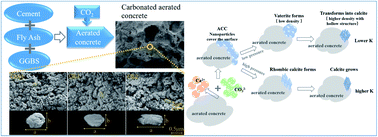Morphological characteristics of calcium carbonate crystallization in CO2 pre-cured aerated concrete
Abstract
Early-stage CO2 curing technology for alkaline construction materials (such as cement concrete) has gained increasing interest owing to the advantages of material properties improvement and high potential of CO2 sinking. Less attention, however, has been paid to morphological characteristics of CaCO3 in carbonated cement concrete. The crystal structure and micromorphology of CaCO3 in an early-age aerated concrete (AC) cured under CO2 gas pressures of 0.1, 1, and 2 bar were investigated. The fabricated AC has a high CO2 sorption capacity (∼35 g CO2 per 100 g cement in a 100 mm cube). The morphological characteristics of CaCO3 were statistically analyzed in terms of long-axis length (b), short-axis length (a), and aspect ratio (K = b/a). As CO2 pressure increases, b is almost unchanged from 0.8–1.8 μm, a decreases from 0.7 to 0.4 μm, and, consequently, K increases from 1.3 to 2.5. The different CaCO3 crystal morphologies in AC are ascribed to the CO2 pressure-associated crystal transformation processes: low gas pressure induces a symmetric CaCO3 growth, while high gas pressure causes a faster calcite growth at the crystal tip ends. The findings would deepen the understanding of CaCO3 crystal formation under different CO2 curing pressures for tuning the microstructure of CO2-cured cement concrete.



 Please wait while we load your content...
Please wait while we load your content...